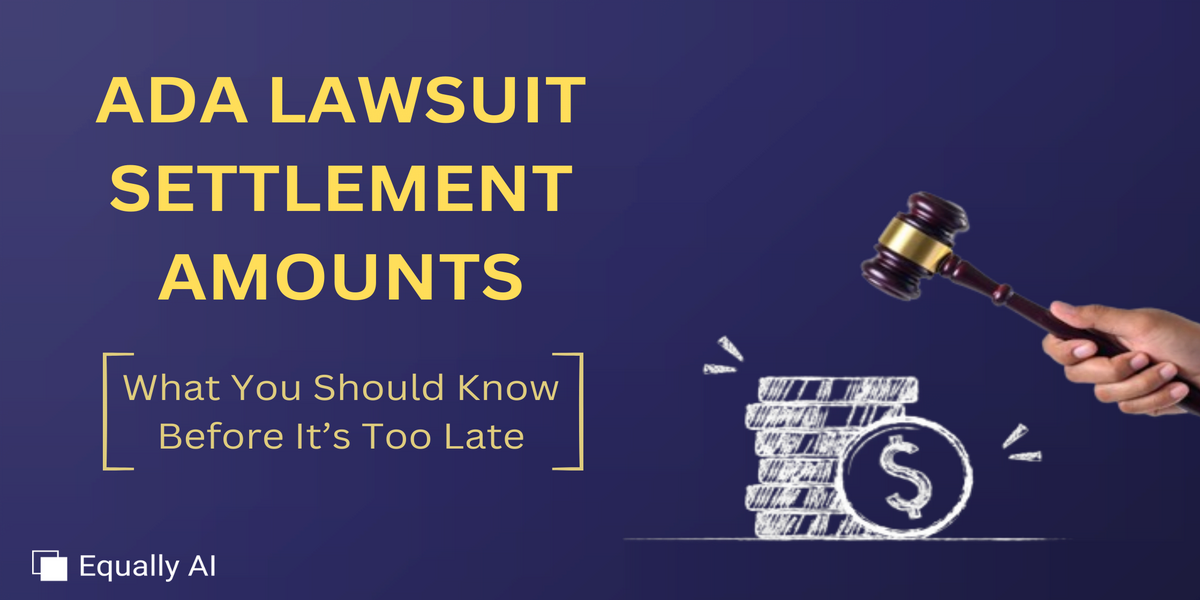ADA lawsuit settlement amounts can be hefty, but the real price of non-compliance goes beyond monetary fines. Understanding these hidden costs, not just the payout amounts, is the key to protecting your business from potential legal issues in the future.
In recent years, there’s been a steady increase in ADA lawsuits, especially focusing on website and mobile app accessibility. Many of these lawsuits target small businesses, not just corporate giants. This rising trend sends a clear message: ‘Get your digital house in order, or pay the price’.

Facing an ADA Lawsuit? Here’s What You Should Know: How to Fight an ADA Website Lawsuit
That said, the purpose of this article is not to encourage lawsuits in any way. Rather, it’s to help equip you with essential information about ADA lawsuit settlement trends. Knowing what’s at stake and the reasons behind these lawsuits is your first step in protecting your business from potential legal headaches.
Understanding ADA Web Accessibility Lawsuits
At its core, ADA non-compliance means your digital content or technology – website or app – has some barriers that prevent people with disabilities from using it fully. Think of it like this: if a wheelchair user can’t enter a store due to a missing ramp, the same principle applies online. For example, if your images lack alt text, it’s like hanging a sign with invisible ink for those using screen readers.
In 2017, the ADA lawsuit against Blue Apron, an American food delivery provider, caught everyone’s attention. Why? Because Blue Apron operates online, without any physical stores. This lawsuit made it explicitly clear that websites must be accessible to everyone, just like physical locations. It showed that online businesses also need to be ADA-compliant, highlighting the need for digital accessibility
Why is ADA non-compliance on websites such a big deal?
Consider the case of the boutique Avanti Hotel, which faced an ADA lawsuit over its inaccessible website. The hotel management faced a harsh reality. Improving the website’s accessibility would cost around $3,000 – a sum they were willing to pay. However, the lawsuit also sought damages, increasing potential expenses to about $8,000 to $13,000 in settlement fees alone.
Fighting the lawsuit was an option, but the financial implications would have been more than a small business like Avanti could bear. They faced the risk of paying up to $25,000 in damages and attorney fees if the court ruled against them. As a temporary measure, the hotel simplified several website pages – including the homepage – to plain text.
The lawsuit likely hit Avanti’s business hard. It caused financial stress and forced them to simplify their website. This change might have turned away potential guests, damaged the hotel’s brand image, and lowered trust. Customers looking online could find the basic site less appealing and choose competitors with more engaging websites instead. This situation shows how ADA non-compliance can lead to legal troubles, loss of revenue and damaged reputation.
Common Web Accessibility Issues that lead to ADA Lawsuits
When it comes to ADA lawsuits, certain web and app accessibility issues crop up more often than others. Here’s are some key issues you need to address to protect your business:
- Images without accessible alt text
- Videos without captions or transcripts
- Keyboard trap and other keyboard-only access barriers
- Poor color contrast ratio
- Use of color alone to convey information
- Lack of visible focus indicator
- Empty or redundant links
- Missing error identification
- Poor document accessibility
- Missing form labels and instructions
Businesses facing ADA lawsuits often find that these issues can have a huge impact on legal compliance and customer satisfaction. Taking proactive steps to find and fix them reduces the risk of an unsatisfied, excluded user taking legal actions against you. Besides, it also enhances your site’s overall user experience for everyone, which potentially leads to more conversions.
💡 Bonus tip: Small businesses in the U.S that are ADA-compliant may be eligible to claim ADA tax credit of up to $5,000.
Factors that Influence ADA Lawsuit Settlement Amounts
ADA lawsuit settlement amounts vary greatly depending on the several factors. These include:
1. Severity of the issue
Industry experts measure accessibility barriers against three WCAG conformance levels: A, AA, and AAA. Issues that violate Level A standards are more severe because they mean the website lacks the most basic accessibility features. This could lead to potentially higher settlements. As a rule of thumb, always aim to meet Level AA standards to reduce legal risks and ensure broader accessibility.
2. Size of the business
Small to medium-sized businesses may settle cases under $25,000 or less, especially if they quickly take corrective actions. Larger companies, on the other hand, may see settlement figures climb into the hundreds of thousands. This might be due to their ability to pay more and the heavier impact their non-compliance has on people with disabilities.
3. Frequency of the violation
The more frequently your business violates ADA guidelines, the higher the fines and settlements you could face. A first-time violation can attract a fine of up to $75,000, with additional violations doubling it to $150,000. That means that repeated non-compliance not only compounds legal risks but also increases financial penalties.
4. Remediation actions taken
Businesses that address accessibility issues before or during litigation can negotiate lower settlements. Taking proactive efforts to comply with the ADA shows good faith and can reduce penalties.
Beyond The Figures: The Hidden Cost of Non-compliance
When it comes to ADA compliance lawsuits, focusing solely on the potential settlement amounts doesn’t provide the full picture of the financial risks involved. Litigation costs, reputational damage, and lost revenue can far exceed any settlement figure, highlighting the costly gamble of non-compliance.
Litigation costs
Defending against an ADA lawsuit is an expensive business. Attorney costs, court fees, and expenses related to compliance audits can quickly accumulate, especially in cases that drag on. Depending on the complexity of the case, businesses might spend upwards of $50,000 to $100,000 in legal defense alone. This amount does not include any settlement paid to the plaintiff or corrective measures required by the court.
Reputational damage
Reputational damage is harder to quantify but can be more harmful and long-lasting. In this digital age, news of an ADA lawsuit can quickly spread through social media and online forums. Such negative publicity often tarnishes the company’s brand image, leading to lost sales and decreased customer loyalty. Plus, the intangible costs of rebuilding a brand’s reputation can far exceed the tangible legal expenses.
Lost revenue
The revenue implications of an inaccessible website or app extend beyond the direct costs of litigation. The CDC reports that one-in-four adults in the U.S. have some type of disability. Ignoring this population is not just a missed opportunity in terms of sales but also a failure to capture a loyal customer base that values accessible brands. Moreover, accessibility features benefit all users, not just those with disabilities, leading to increase in overall customer satisfaction and engagement.
Recent Cases of ADA Lawsuit Settlement Amounts

Some high-profile ADA lawsuits have made headlines in recent years, showing what happens when businesses fail to meet compliance (on both physical and online spaces). These cases highlight not just the financial consequences, but also the strategic changes you need to make to protect your business. Let’s take a look a few:
The State of California’s $66 million website
In 2017, the California Department of Parks and Recreation hired two government contractors to build a website for them. The website promised universal access to online camping reservations and cost a whopping $66 million. Although the vendors claimed the site was WCAG 2.0 AA compliant, it wasn’t. A visually impaired camper sued them (the contractors, not the website owner) and won a settlement valued at more than $2 million.
MedStar Health, Inc.
On January 30, 2024, the U.S. filed an ADA Title III complaint against Medstar Health, Inc. for discriminations against patients with mental and cognitive disabilities. To settle, MedStar agreed to a Consent Decree and committed to pay $440,000 to the affected individuals. It also agreed to update its ADA compliance policies, train its staff on these changes and report any future incidents concerning the exclusion of support persons to the Department.
L.A Community College District
In May 2023, two blind students and the National Federation of the Blind filed an ADA lawsuit against the Los Angeles Community College District (LACCD). The students argued that the district failed to provide them with accessible course materials and educational technology. Before suing, they had asked the LACCD for help, but got none. In the end, students won a settlement of over $240,000.
Champaign-Urbana Mass Transit District (MTD)
In December 2021, the U.S. reached a settlement with the Champaign-Urbana Mass Transit District (MTD) over alleged ADA violations. The deal mandates that MTD make its website and apps accessible to those with visual and manual disabilities. Specifically, MTD must upgrade its website and apps to meet WCAG 2.1, Level AA standards. MTD also committed to investing at least $100,000 to enhance services for passengers with disabilities.
Kent Hospital
In December 2023, Kent Hospital settled with the U.S. Attorney’s Office over ADA allegations of not providing adequate communication support to a deaf patient. The hospital committed to updating ADA policies, ensuring access to qualified interpreters, staff training, and monitoring complaints. They also had to pay the complainant $30,000, plus a $5,000 legal fine.
Lessons Learned and Compliance Strategies for Business Owners
From these and other high-profile settlements, several key lessons emerge:
- Make your website or app accessible right from the beginning. We really can’t overstate this! Prioritizing accessibility from the onset will help avoid legal troubles, save money, and protect your reputation.
- Keeping your site or app accessible isn’t a one-and-done deal. You need to keep checking and tweaking things as technology and standards change.
- Engage with people in disability communities. Get their input on your site or app. This way, you make sure your accessibility fixes work for those who need them.
- Educate your stakeholders on the importance of ADA compliance and the potential risk for non-compliance.
We're Here to Help You
ADA web accessibility lawsuits are a growing concern for businesses, underscoring the urgent need to make digital platforms accessible to everyone.
We understand the challenges and opportunities this presents and are here to support you. Our innovative AI web accessibility platform combines automated tools and detailed manual reviews with full user control to help you meet ADA, AODA, Section 508, and international standards. Contact us to learn more.
Disclaimer: This article is intended for informational purposes only and does not serve as legal or professional advice. It provides a general overview of ADA web accessibility lawsuits and considerations for businesses. For legal advice and assistance regarding ADA compliance and defending against an ADA lawsuit, please consult with qualified legal professionals.




